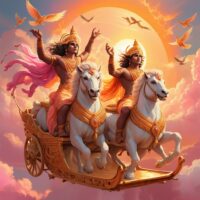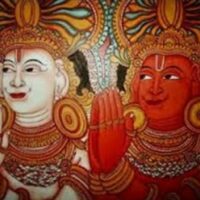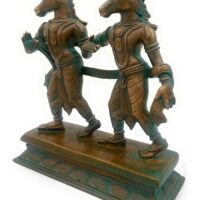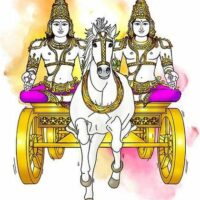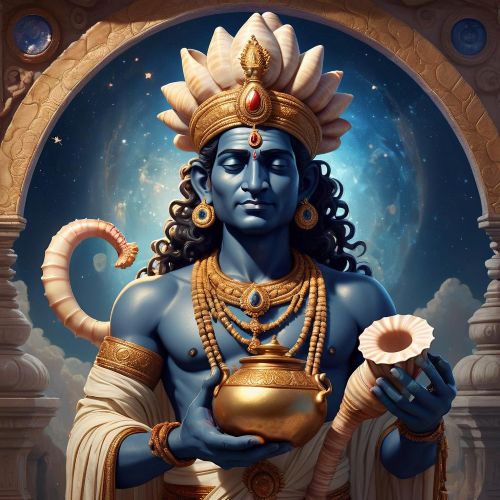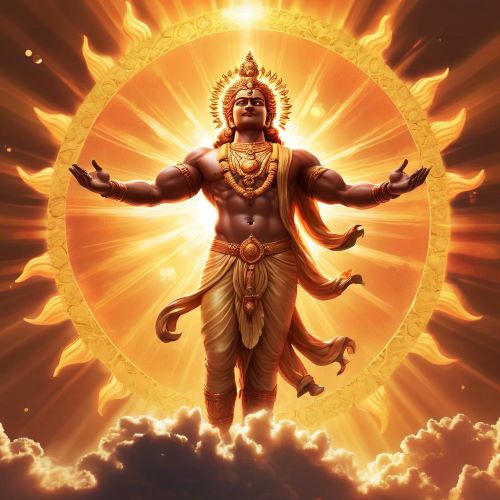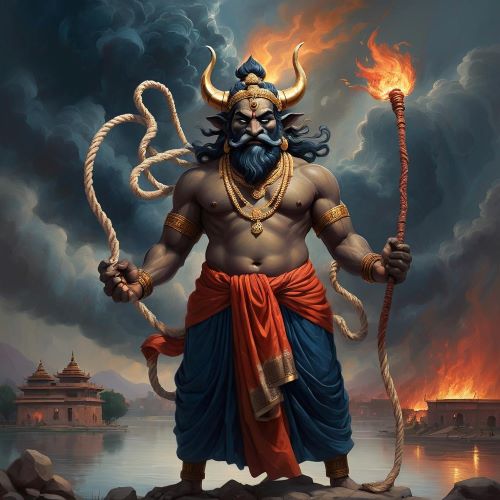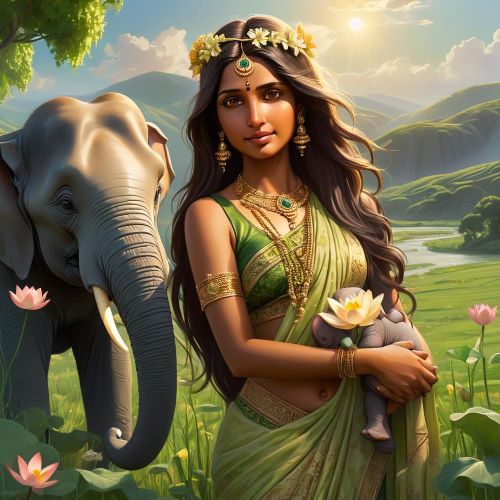Ashvins : Twin Gods of Healing
Listen
At a glance
| Description | |
|---|---|
| Origin | Indian Mythology |
| Classification | Gods |
| Family Members | Surya (Father), Sanjana (Mother), Yama, Revanta (Brothers), Yamuna (Sister) |
| Region | Indian |
| Associated With | Horses, Healing, Dawn |
Ashvins
Introduction
In Indian mythology, the Ashvins stand out as divine twin deities revered for their healing powers and swift interventions. Known as celestial horsemen, they occupy a special place in Vedic tradition as bringers of light and life. The earliest references to the Ashvins appear in the Rigveda, where nearly sixty hymns are dedicated to their praise, making them some of the most celebrated gods of the Vedic pantheon. Their name translates to “possessors of horses,” reflecting both their swiftness and deep symbolic link with vitality. Ancient scholars debated their true nature, with interpretations ranging from personifications of cosmic forces to embodiments of dual aspects of existence such as day and night or the sun and moon. Central to their myth is their role as divine physicians, traveling the skies to aid those in need, both mortal and immortal.
Physical Traits
The Ashvins are typically described as eternally youthful, radiant, and graceful, riding together in a shining golden chariot drawn by tireless steeds. Their beauty is emphasized in the Vedas, often compared to the first rays of dawn breaking across the horizon. Sometimes their chariot is said to be drawn by birds or other supernatural creatures, symbolizing their ability to traverse realms swiftly. The horses associated with them never age or tire, mirroring the Ashvins’ own ageless vitality. In certain depictions, their equine association goes further, with features or forms resembling horses—emphasizing speed, fertility, and their divine origin story. Their very appearance captures the essence of motion, light, and rejuvenation.
Family
According to the most well-known version of their origin, the Ashvins are the twin sons of Surya, the sun god, and Saranyu (also called Sanjna), a goddess who transformed into a mare to escape her husband’s blazing heat. In her equine form, she gave birth to the twins, which explains their strong and enduring bond with horses. They share their divine heritage with siblings such as Yama, the god of death, Yamuna, the river goddess, and Revanta, a solar warrior deity. In some traditions, their consort is Suryā, the daughter of Savitri, who chose the Ashvins for their unmatched qualities. This lineage firmly roots them among the solar deities while giving them a unique, compassionate role focused on rescue and restoration rather than dominion or destruction.
Other names
Throughout the Vedic and post-Vedic texts, the Ashvins are referred to by several alternative names and titles. The term Ashwini Kumaras—“horse-born youths”—is perhaps the most common. In the Rigveda, they are also called Nasatya and Dasra, names that later became associated with each twin individually. Nasatya carries connotations of truth, helpfulness, and healing, while Dasra is linked to swift and miraculous interventions. In different regions and contexts, they may also be known as the Divya Vaidyas (divine physicians) or Abdhijau (ocean-born), a title highlighting another myth of their mysterious origins. Each name adds nuance to their identity, reflecting both their attributes and the cultural diversity of their worship.
Powers and Abilities
The Ashvins’ reputation rests chiefly on their unmatched healing abilities. As the physicians of the gods, they are credited with restoring sight to the blind, curing incurable diseases, reviving the aged, and even bringing the dead back to life in certain tales. They are said to have rejuvenated the sage Chyavana, granted fertility to the childless, and rescued the drowning Bhujyu from the depths of the ocean. Beyond their healing prowess, they are bringers of light, heralding the dawn and dispelling darkness. Their interventions are swift, often arriving in moments of dire need, earning them a role akin to divine first responders. In Vedic hymns, they are also praised for providing both physical sustenance, such as food and drink, and spiritual gifts, such as wisdom and clarity. Their powers extend into matchmaking and blessing marriages, further underscoring their association with life, renewal, and harmony.
Modern Day Influence
The Ashvins’ legacy continues to resonate in modern times, both in spiritual practice and cultural symbolism. In Ayurveda, they are honored as the original masters of healing, with the tradition holding that even the legendary physician Dhanvantari learned from them. In Vedic astrology, the Ashvini Nakshatra—named after them—is the first lunar mansion and is associated with vitality, initiative, and healing energy. Their archetype as divine twins echoes in mythologies across the world, such as the Greek Dioscuri, underlining a shared Indo-European heritage of twin deities who rescue, heal, and protect. In contemporary Indian culture, the Ashvins often feature in literature, art, and even modern wellness philosophies as symbols of balance, cooperation, and rejuvenation. For many, invoking their names is a way of seeking not only physical health but also harmony between opposing forces—light and dark, body and soul, action and rest.
Related Images
Source
Bisht, S. (n.d.). Ashvins: Gods of Health and Medicine. Amazon.com.
Ashvins. (n.d.). Wikipedia. Retrieved from https://en.wikipedia.org/wiki/Ashvins
Ashvins – Ashwins – Vyasa Mahabharata. (n.d.). Vyasa Mahabharata. Retrieved from https://www.vyasaonline.com/encyclopedia/ashvins/
Ashvini Kumaras | Roshani Chokshi Wiki – Fandom. (n.d.). Fandom. Retrieved from https://roshanichokshi.fandom.com/wiki/Ashvini_Kumaras
Aswins, the Hindu Gods of Healing and Medicine. (n.d.). Hindu Website. Retrieved from https://www.hinduwebsite.com/hinduism/concepts/aswins.asp
Bisht, S. (n.d.). Ashvins: Gods of Health and Medicine. Amazon.com.
Doniger, W. (1975). Hindu myths : a sourcebook translated from the Sanskrit.
Handbook of Hindu Mythology. (2003). Semanticscholar.org.
Jog, K. P. (n.d.). Asvins: The Twin Gods in Indian Mythology Literature & Art. Amazon.com.
Mittal, R. (n.d.). The Ashvins – Pujaabhishekam. Pujaabhishekam. Retrieved from https://www.pujaabhishekam.com/blog/2858?srsltid=AfmBOopzorSRtKNVp382RmEN3mqifAtZEVEIuAxrwHZ4RqkIVsMHPq_i
The Ashvins: Hindu Mythology’s Divine Horsemen-Twin Gods of …. (n.d.). Poojn.in. Retrieved from https://www.poojn.in/post/30236/the-ashvins-hindu-mythologys-divine-horsemen-twin-gods-of-healing-light?srsltid=AfmBOoovCk4qGgsh-cfMmRSS9VKI_KZkuo8m9NHZYFi19uMRzIUKdeZx
The Ashvins: Hindu Mythology’s Divine Horsemen-Twin …. (n.d.). Poojn.in. Retrieved from https://www.poojn.in/post/30236/the-ashvins-hindu-mythologys-divine-horsemen-twin-gods-of-healing-light?srsltid=AfmBOorhjBS0ot7n4MC9hH8XPttS0U69Puvevo7i9jt7vzoukzKEHPbM
The Ashwins – The Incarnate Word. (n.d.). Incarnateword.in. Retrieved from https://incarnateword.in/compilations/the-secret-of-the-veda-thematically-structured/the-ashwins-1
Timeline: Ashvins – World History Encyclopedia. (n.d.). World History Encyclopedia. Retrieved from https://www.worldhistory.org/timeline/Ashvins/
Two Ashvins: Significance and symbolism. (2025, June 21). Wisdomlib.org. Retrieved from https://www.wisdomlib.org/concept/two-ashvins
Frequently Asked Questions
What is lorem Ipsum?
I am text block. Click edit button to change this text. Lorem ipsum dolor sit amet, consectetur adipiscing elit. Ut elit tellus, luctus nec ullamcorper mattis, pulvinar dapibus leo.
What is lorem Ipsum?
I am text block. Click edit button to change this text. Lorem ipsum dolor sit amet, consectetur adipiscing elit. Ut elit tellus, luctus nec ullamcorper mattis, pulvinar dapibus leo.
What is lorem Ipsum?
I am text block. Click edit button to change this text. Lorem ipsum dolor sit amet, consectetur adipiscing elit. Ut elit tellus, luctus nec ullamcorper mattis, pulvinar dapibus leo.
What is lorem Ipsum?
I am text block. Click edit button to change this text. Lorem ipsum dolor sit amet, consectetur adipiscing elit. Ut elit tellus, luctus nec ullamcorper mattis, pulvinar dapibus leo.
What is lorem Ipsum?
I am text block. Click edit button to change this text. Lorem ipsum dolor sit amet, consectetur adipiscing elit. Ut elit tellus, luctus nec ullamcorper mattis, pulvinar dapibus leo.


